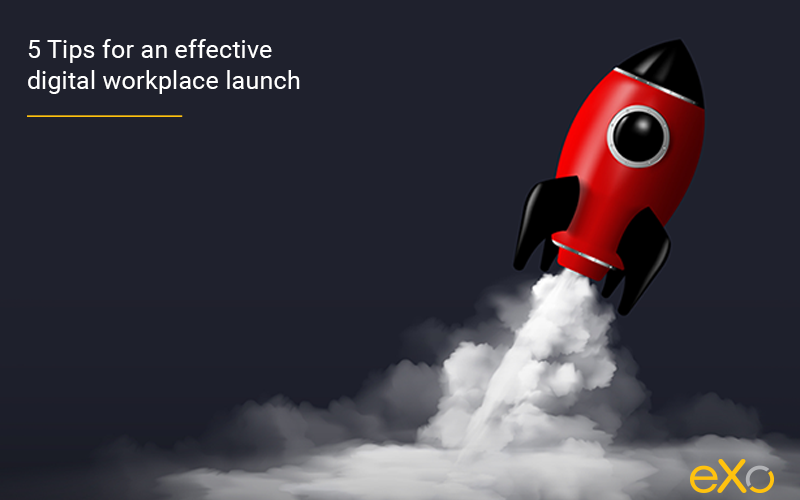- Fares Laroui
- January 5, 2021
5 tips for an effective digital workplace launch
Every digital workplace project is driven by the desire of businesses to address a variety of challenges, ranging from ineffective internal communications and low engagement rates to poor collaboration and productivity.
Although a typical digital workplace can help overcome these challenges through multiple features that address the whole scope of collaboration, businesses often encounter difficulties in persuading employees to use them, making the project doomed from the start.

Content
This raises two important matters: (1) why employees are reluctant to use their new digital workplace, and; (2) how project teams can increase user adoption rates and put a digital workplace into operation.
In this blog post we will try to answer both questions, and look at various steps to bring about the success of your digital workplace launch.
Main causes of low digital workplace adoption
In a blog post I wrote a while back, “Why employees love to hate your intranet”, I described some of the reasons why employees adopt a digital workplace slowly, or refuse to use it altogether.
The number one reason is a failure to study and understand the organisation’s needs and its teams’ needs. As the saying goes, “By failing to prepare you are preparing to fail.” Implementing a digital workplace (or building one from the ground up) and simply hoping for the best is a common mistake made by many businesses. More often than not, the result is a solution that is out of touch and offers no real added value, giving employees no choice but to stick with what they already have. This will eventually solidify their resistance to change.
Additionally, we have seen many businesses pay little or no attention to the content they share with their employees. Unsurprisingly, a digital workplace with poor communication and information flow will not attract users and keep them engaged in the long run. The absence of varied content, be it informative, educational, or fun, gives users no reason to log in, which will eventually push them to use other platforms to get information.
Last but not least, with any new product launch, the emphasis should be on communication. Product launch emails play a crucial role in reaching out to potential customers, sharing key features, and generating excitement. “If you build it, they will come” is a proverb often used to play down the power of marketing and communication and consider only the product.
Although having a product that meets the needs of its target users is key, they won’t adopt it if they don’t know it exists, or don’t understand its value or know how to use it. Expecting users to adopt a new digital workplace while doing nothing to promote it is a trap that many project teams fall into.
So, what steps must we follow to properly launch a digital workplace and ensure its initial and continuous adoption?
5 steps to get your digital workplace launch right
1. Find the “Why”
The first step in choosing a digital workplace and being able to promote it effectively is to understand why your employees would need it. As mentioned earlier, preparation is essential, to understand the various internal challenges. We often see project teams engage in digital workplace projects while completely overlooking or paying little attention to this initial phase. The assumption is made that a digital workplace will streamline communication and foster collaboration, among a host of other benefits. In a way it is true. Most businesses use digital workplace solutions to achieve these objectives. But what about particular needs? More importantly, have you thought about alternative solutions? They might suit your teams better than the one you are proposing.
Finding the “Why” for a digital workplace project is of the utmost importance. It can help you find the right fit for your teams, and determine the objectives and key metrics in order to measure the success of the launch, and later of the project as a whole.
2. Identify your digital workplace ambassadors
Any marketing or promotional activity needs ambassadors. Within a business, the ambassadors are ideally those employees who can assist in promoting your message to the whole organisation. By using marketing automation, it is possible to ensure that all the basics of marketing and promotion are taken care of so that ambassadors within the business can help to spread your message even more effectively.
The content of your launch campaign (newsletters, promotional videos, events, and so on) will be less effective if it is not reinforced by a group of selected individuals who have influence within their teams and throughout the organisation. What we witness in most digital workplace projects is that the project team members and the decision-makers are the people responsible for spreading the world and building momentum. This is a good first step, as these individuals are well-informed and well-placed to talk on behalf of the project.
You can build on this by recruiting other ambassadors who are willing to represent their teams and work on attracting their peers to do the same. For this to be effective, think of organising tailored training sessions to familiarise the early adopters with the platform. In this way they can start using it to its full capacity, and then of course share their experiences with others.
3. Build the digital workplace brand
When introducing any new product, but particularly a digital workplace, the intended customers and users have to resonate and identify with the brand.
In general, a brand is what differentiates offerings from each other and how they are perceived by users. Brand perception here is key. In the case of a digital workplace project, users won’t be motivated to log in to a platform that doesn’t reflect their workplace dynamics, doesn’t have an appealing design, isn’t easy to navigate, and the list goes on. What can be done about this?
At the basic level, brands are about names, colours, themes, specific terms, etc. These distinct elements are the foundation of a digital workplace project, especially at its launch. Think about giving the platform a catchy name that employees can easily remember (don’t over-complicate things). Next comes the look and feel of the digital workplace. Try to involve employees as much as possible in decisions on the UX and UI. For example, take polls where employees can vote for their preferred theme colour, for example, or a specific layout for certain pages and spaces. In this way you can ensure that employees are given what is suitable for them, and especially generate enthusiasm and anticipation to see the platform in action.
4. Training and onboarding
Before the big day, you have to plan how to onboard and train users so they won’t be confused when they first login. Think of adding a checklist to the homepage. Upon logging in, users will find everything they need to get started and to perform basic actions such as completing a profile, adding connections, joining spaces, posting their first message, etc.
To help users to learn about more advanced features, create dedicated training spaces where they can easily find detailed tutorials and how-to guides, so they can learn at their own pace.
5. Plan the big day
Before the launch day, it is important to establish the types of content and promotional material that resonate well with your employees. For that, you can perform a content audit that will be the basis firstly for your communication campaign, and later on, for your digital workplace content plan. The objective of the promotional campaign is to build awareness and create anticipation and buzz around the project. You also want the campaign to be informative and educational, communicating its value to your employees through ‘sneak peek’ posts or short tutorial videos and check the efficiency with a campaign management software.
There are plenty of digital workplace launch ideas, including webinars, launch videos, blog posts, giveaways, and welcome packages. Yet the fundamentals don’t change. The objective on the first day is to create a positive and enjoyable experience to increase the likelihood of users exploring the platform and coming back for more.

FREE WHITE PAPER
Types of Digital workplace solutions
The modern workplace has evolved significantly in recent years, with advancements in technology, the growing number of tools …
FAQs
You will find here Frequently Asked Questions about digital workplace with all the answers in one place.
What is a digital workplace?
A digital workplace is a next generation of intranet solutions or intranet 2.0 that is based on three pillars: communication, collaboration and information. In a way this definition is true but it doesn’t cover the whole spectrum of the term.
Here are some definitions of digital workplace:
- An evolution of the intranet
- A user centric digital experience
How to launch an effective Digital Workplace?
- Understand users’ needs
- Identify your digital workplace ambassadors
- Build the digital workplace brand
- Training and onboarding
- Plan the big day
What does digital workplace really mean?
The digital workplace is the virtual, digital equivalent of the physical workplace. It is a holistic user-centered solution used to connect, engage, and empower employees. Through an employee-centered hub, it encompasses a set of tools, applications, and platforms for a complete work experience. ➝ Find out some definitions of the digital workplace
How to be a good digital workplace manager?
- Analytical skills and approach
- Focus on employees
- Communication and strategic vision
- Tags: Digital workplace, Tips & Tricks
4.8/5 - (138 votes)
I am a product marketing specialist at eXo. My role is to assist marketing and sales teams in their operations and present our digital workplace solution to the world. I mainly blog about the latest tech trends, digital transformation, internal communication and how to navigate through eXo Platform.
Related posts
- All
- eXo
- Digital workplace
- Employee engagement
- Open source
- Future of work
- Internal communication
- Collaboration
- News
- intranet
- workplace
- Knowledge management
- Employee experience
- Employee productivity
- onboarding
- Employee recognition
- Change management
- Cartoon
- Digital transformation
- Infographic
- Remote work
- Industry trends
- Product News
- Thought leadership
- Tips & Tricks
- Tutorial
- Uncategorized
Leave a Reply
( Your e-mail address will not be published)
Connexion
0 Comments
Commentaires en ligne
Afficher tous les commentaires


